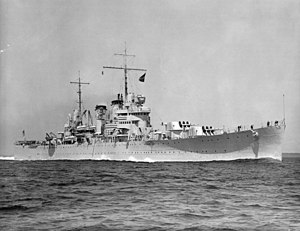| Battle of Gela (1943) | |||||||
|---|---|---|---|---|---|---|---|
| Part of the Allied invasion of Sicily in the Mediterranean theatre of World War II | |||||||
 Brooklyn-class cruisers Boise (pictured) and her sister ship Savannah, demonstrated the effectiveness of naval gunfire against tanks. | |||||||
| |||||||
| Belligerents | |||||||
|
|
| ||||||
| Commanders and leaders | |||||||
|
|
| ||||||
| Units involved | |||||||
|
Gela beachead: Naval support: |
Gela beachead: North of Gela: Air support: | ||||||
| Casualties and losses | |||||||
|
U.S.:[1] 2,300 casualties 1 destroyer sunk[2] |
Italian:[3] 3,350 killed 5,000 wounded 2,000 prisoners[4] German: 630 killed, wounded, and prisoners 14 tanks | ||||||
The amphibious Battle of Gela was the opening engagement of the American portion of the Allied Invasion of Sicily during World War II. United States Navy ships landed United States Army troops along the eastern end of the south coast of Sicily; and withstood attacks by Luftwaffe and Regia Aeronautica aircraft while defending the beachhead against German tanks and Italian tanks of the Livorno Division until the Army captured the Ponte Olivo Airfield for use by United States Army Air Forces planes. The battle convinced United States Army officers of the value of naval artillery support, and revealed problems coordinating air support from autonomous air forces during amphibious operations.[5]
- ^ "WWII Campaigns: Sicily".
- ^ USS Maddox (ii) (DD 622)
- ^ Andrea Augello, Uccidi gli italiani: Gela 1943, la battaglia dimenticata, Mursia, Milano 2009, p. 120.
- ^ Part of the 5,000 wounded are also included among the 2,000 prisoners. Total casualties of the Livorno Division numbered 214 officers and 7,000 men, of whom 1,300 were taken prisoner (Alberto Santoni, Le operazioni in Sicilia e in Calabria, Italian Army Historical Branch, 1989, p. 201).
- ^ Allard, Dean (1997). "The U.S. Navy Comes Ashore in the Med". Naval History. 11 (5). United States Naval Institute: 47–48.